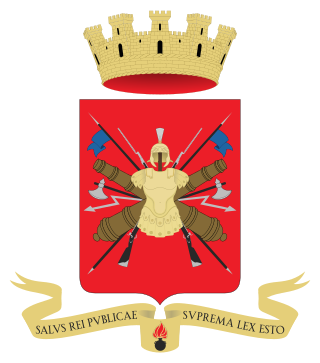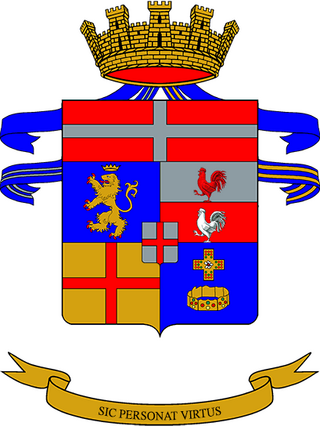
The Italian Army is the land force branch of the Italian Armed Forces. The army's history dates back to the Italian unification in the 1850s and 1860s. The army fought in colonial engagements in China, Libya, Northern Italy against the Austro-Hungarian Empire during World War I, Abyssinia before World War II and in World War II in Albania, Balkans, North Africa, the Soviet Union, and Italy itself. During the Cold War, the army prepared itself to defend against a Warsaw Pact invasion from the east. Since the end of the Cold War, the army has seen extensive peacekeeping service and combat in Afghanistan and Iraq. Its best-known combat vehicles are the Dardo infantry fighting vehicle, the Centauro tank destroyer and the Ariete tank and among its aircraft the Mangusta attack helicopter, recently deployed in UN missions. The headquarters of the Army General Staff are located in Rome opposite the Quirinal Palace, where the president of Italy resides. The army is an all-volunteer force of active-duty personnel.
The article provides an overview of the entire chain of command and organization of the Italian Army after the reform of 1 May 2024 and includes all active units as of 1 May 2024. The Armed Forces of Italy are under the command of the Italian Supreme Defense Council, presided over by the President of the Italian Republic. The Italian Army is commanded by the Chief of the Army General Staff or "Capo di Stato Maggiore dell’Esercito" in Rome.
On March 1, 1984 the Italian Institute for Disarmament, Development and Peace (Istituto di ricerche per il disarmo, lo sviluppo e la pace in Rome published the entire Italian Army order of battle down to company level – this was justified by the radical party as one of its core demands was total disarmament of Europe, even though the data which was published was top secret. The Radical Party dissolved in 1989 and the IRDISP followed suit in 1990. But Radio Radicale has survived, and the OrBat can still be found today on the homepage of the radio.

The Sassari Mechanized Brigade is a mechanized infantry brigade of the Italian Army, based on the island of Sardinia. Its core are three infantry regiments which distinguished themselves in combat during World War I. Carrying the name of the Sardinian city of Sassari the brigade's coat of arms is modeled after the city's coat of arms. The brigade is part of the Division "Acqui".

The Cavalry Brigade "Pozzuolo del Friuli" is a brigade of the Italian Army, based in the Friuli-Venezia Giulia and Veneto regions. The Brigade consists of a command unit, a cavalry regiment, an amphibious infantry regiment, an artillery regiment, an engineer regiment and a logistic regiment.

The Airmobile Brigade "Friuli" is an airmobile brigade of the Italian Army, based mainly in the Emilia-Romagna region. The brigade was part of the 1st Defence Forces Command until it was transferred to the Division "Friuli". The brigade's coat of arms depicts a stylized version of the Rocca di Monfalcone castle near the city of Monfalcone in the Friuli region, where the brigade distinguished itself during World War I. Since 1 July 2019 the brigade is part of the Division "Vittorio Veneto".

The Mechanized Brigade "Granatieri di Sardegna" is a mechanized infantry brigade of the Italian Army, based in Rome and central Italy. The brigade fields one of the oldest regiments of the Army and is one of the guard regiments of the President of Italy. The name of the unit dates back to the Kingdom of Sardinia and not the eponymous Mediterranean island of Sardinia. The brigade is part of the Division "Acqui".

The 132nd Armored Brigade "Ariete" is currently the only active armored brigade of the Italian Army. Its core units are tank and Bersaglieri regiments. The brigade's headquarters is in Pordenone, and most of its units are based in the North-East of Italy. The brigade's name comes from the battering ram. The brigade draws much of its historical traditions from the 132nd Armored Division "Ariete," which fought in the Western Desert Campaign of World War II. In 1948, the Ariete was reconstituted as a division and remained active until 1986. Today the brigade is part of the Division "Vittorio Veneto".

The Mechanized Division "Folgore" was a mechanized division of the Italian Army. Its core units were three mechanized brigades. The brigades headquarters was in the city of Treviso.
The Italian Liberation Corps was a corps of the Italian Co-belligerent Army during the Italian campaign of World War II. After the announcement of the Armistice of Cassibile on 8 September 1943 the Italian government began the formation of units to fight on the allied side against Germany. On 18 April 1944 the Italian Liberation Corps was formed, which after an intense cycle of combat operations was disbanded on 24 September 1944 to form division-sized combat groups.
The following is a hierarchical outline for the Italian Army at the end of the Cold War. It is intended to convey the connections and relationships between units and formations.
With the 1975 reforms the Italian Army abolished the regimental level and replaced it with brigades made up of multiple arms. During the reform the army disbanded 48 regimental commands and reduced its force by 87 battalions. A further ten regimental commands were used to raise ten new brigade commands. Ten training centers, which for traditional reasons had carried the names of regiments, were also disbanded. The reduction in units also allowed to mechanize most of the remaining units in Northern Italy and Italy's defense strategy changed from a hold-at-all-costs territorial defense to one of mobile warfare.

The 3rd Regiment "Granatieri di Sardegna" is a unit of the Italian Army's infantry arm's Granatieri (Grenadiers) speciality. The regiment was active for a short time in 1849 during the First Italian War of Independence and then reformed in 1926 and assigned to the Infantry Division "Granatieri di Sardegna". In 1935-36 the regiment's I Battalion fought in the Second Italo-Ethiopian War. In 1939 the regiment became an autonomous unit and moved to Tirana in occupied Albania. There the regiment was renamed 3rd Regiment "Granatieri di Sardegna e d'Albania" and participated in the Greco-Italian War. For its conduct during the war the regiment was awarded Italy highest military honor the Gold Medal of Military Valor. After the announcement of the Armistice of Cassibile on 8 September 1943 the regiment was disbanded by invading German forces.

The Regiment "Savoia Cavalleria" (3rd) is a cavalry unit of the Italian Army based in Grosseto in Tuscany. The regiment is the reconnaissance unit of the Paratroopers Brigade "Folgore".

The Regiment "Genova Cavalleria" (4th) is a cavalry unit of the Italian Army based in Palmanova in Friuli-Venezia Giulia. The regiment is the highest decorated and oldest cavalry regiment of the Italian Army and the only army unit, whose anniversary commemorates a pre-Risorgimento event. The regiment is the reconnaissance unit of the Cavalry Brigade "Pozzuolo del Friuli".

The Regiment "Lancieri di Montebello" (8th) is a cavalry unit of the Italian Army based in Rome. The regiment is the reconnaissance unit of the Mechanized Brigade "Granatieri di Sardegna" and performs public duties in Rome. The regiment was formed after the Second Italian War of Independence and participated in the Third Italian War of Independence. In World War I the regiment fought dismounted on the Italian front. After the war the regiment was disbanded. During World War II the regiment was reformed and during World War II. After the announcement of the Armistice of Cassibile by the regiment fought against invading German forces at the outskirts of Rome, which earned the regiment a Silver Medal of Military Valor. The regiment was reformed in 1951 and has served since then as one of the guard units of Rome. In 1997 the regiment became the reconnaissance unit of the Mechanized Brigade "Granatieri di Sardegna".

The Regiment "Lancieri di Novara" (5th) is a cavalry unit of the Italian Army based in Codroipo in Friuli-Venezia Giulia. The regiment is the reconnaissance unit of the 132nd Armored Brigade "Ariete".

The Regiment "Lancieri di Milano" (7th) is an inactive cavalry unit of the Italian Army. The regiment was formed after the Second Italian War of Independence and participated in the Third Italian War of Independence. In World War I the regiment fought dismounted on the Italian front. After the war the regiment was disbanded. Shortly before World War II the regiment was reformed. The regiment participated in the Italian invasion of Greece and remained afterwards on anti-partisan duty in Albania, Croatia and occupied Greece. The regiment dissolved in Larissa in Greece after the announcement of the Armistice of Cassibile. During the Cold War the unit served as the reconnaissance group of the Infantry Division "Legnano" and after 1975 of the Mechanized Division "Mantova". In 1986 the group became the reconnaissance group of the Armored Brigade "Pozzuolo del Friuli". At the end of the Cold War the unit was disbanded in 1989.

The 182nd Armored Infantry Regiment "Garibaldi" is an inactive unit of the Italian Army last based in Sacile in Friuli-Venezia Giulia. The regiment was part of the Italian Army's infantry arm and was last assigned to the Infantry Division "Folgore".





























































































































































































































































































































